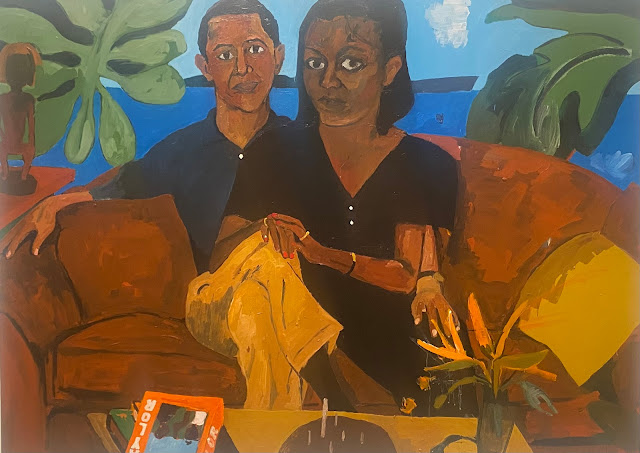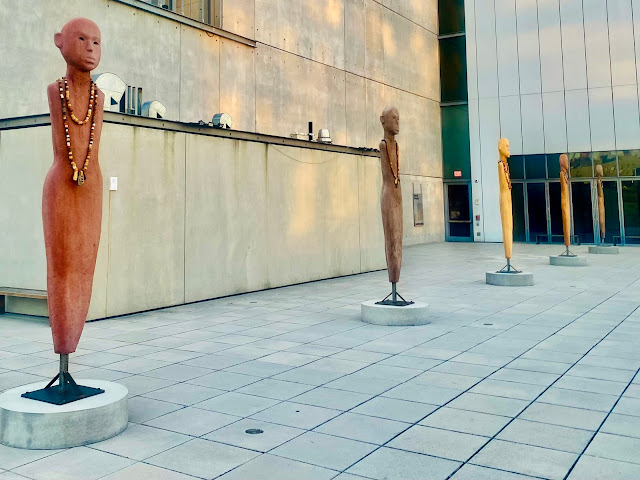Artist Henry Taylor, the youngest of eight children in a California family, portrays himself as Henry VIII, a sly allusion to the erasure of Africans from European art that usually depicted royalty or the landed gentry.
 |
| Untitled (2021) |
 |
| "Cora, (cornbread)" (2008) |
 |
| "THE TIMES THAY AINT A CHANGING, FAST ENOUGH!" (2017) |
 |
| Untitled (2022) |
 |
| "Girl with a Toy Rifle" (2015) |
 |
| Untitled (2006) |
The Whitney exhibition also includes sculpture and installations by Taylor.
One of Taylor's brothers headed the Ventura, California chapter of the Black Panthers.
 |
| Portrait of My Brother Robert Randy Taylor (2010) |
Taylor renders the image as a collage and incorporates it into an installation I found mesmerizing, perhaps because of my admiration for the Panther's advocacy of black self-defense coupled with community services.
 |
| Huey Newton (2007) |
These documents are displayed on the speaker's podium, hidden from view in the photo above.
The installation also includes photos of contemporary African Americans who have died needlessly as a result of the same kind of police violence that gave rise to the Panthers half a century ago.
I won't deny that Black Panther style probably made a bigger impression on me than their politics, at least initially.
 |
| Untitled Installation (2022) |
 |
| Untitled Suitcase (2021) |
 |
| Untitled (2020) |
 |
| "Before Gerhard Richter there was Cassi" (2017) |
 |
| "A Young Master" (2017) |
The Whitney's rooftop views often compete with the sculpture on display, but I particularly enjoyed Rose B. Simpson's "Counterculture." According to the exhibit text, these totemic, contemplative figures, sculpted from clay, represent the indigenous people that traded away Manhattan to the Dutch for shiny trinkets according to old-school education.
With congestion pricing looming, those shiny trinkets aren't looking like such a bad deal at the moment.
What would the Lenape think of Little Island
. . . or the High Line, both artificially created environments that provide urban dwellers with selfie backdrops in a world that almost entirely has lost touch with simple joys of nature.
Back inside the Whitney introduced me to Harry Smith, an unfamiliar, uncategorizable artist whose varied work enchants and alarms. Imagine if the Tin Woodman dropped acid. Now you don't have to!
Smith drew this demonic self-portrait in 1952.
Take the Whitney's staircase for expansive views of the sun setting over New Jersey. Did you know that the Gansevoort Peninsula opened in October?
"Inheritance" on the sixth floor provides Whitney curators with an opportunity to showcase new or rarely seen works dating back to the 1970s. Most birthday videos don't end up in a museum but this one--"Ninety-Three" shot by Kevin Jerome Everson in 2008--did. It's eerily compelling.
Sadie Barnette's father was a Black Panther, too. His surveillance and persecution by the FBI--which resulted in the loss of his job at the United States Post Office--informs her work.
 |
| "Family Tree II" (2022) |
 |
| "Bob's your Uncle" by Joan Wallace (1991) |
 |
| "Sultana's Dream" (partial) by (2018) |
 |
| "United States of Attica" by Faith Ringgold (1971) |
 |
| "Red Exit" (detai) by Andrea Carlson (2020) |
Sturtevant took the concept of candy-based art--pioneered by Ed Ruscha in the "Chocolate Room"--a step farther. You can take a piece. Just one, though, a sign insists. It tasted like a Sugar Baby.
 |
| Blue Placebo (2005) |
I'm generally not a fan of daylight savings time, but it allows you watch the sometimes dramatic change in light over New York while the museum is open. Downtown residents pay big bucks for the incredible views included in the price of a Whitney admission. And because you experience them so infrequently, they're always a treat.
Three exhibits down, one to go: Ruth Asawa Through Line. Not really my cup of tea but a good palate cleanser.
 |
| Untitled (partial, 1961) |
 |
| Untitled (1963) |
I took the High Line, blissfully free of crowds, all the way to Moynihan Station without ever having to descend to ground level.
New York City really does seem like Oz on balmy nights like this.













No comments:
Post a Comment